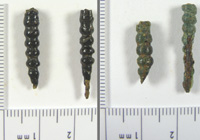Glass beads

Click ^ for larger image.
These are pieces of Roman glass, lengths of small segmented (but not separated) beads on a wire, dimishing in size towards one end. It would perhaps be easy to say these were part of a piece of jewellery, maybe a dangly earring or headdress of some kind: and maybe they were.
There are bone, fossil bone, and faience prototypes for this form of round bead with a hole through the middle so they could be strung. However the original glass segmented beads probably were produced by 'gathering' a tube of glass and introducing a bubble of air which then was drawn out to form a hollow glass rod. This rod then could be crimped at regular intervals and may be then broken into smaller segments. The molton glass was rolled or drawn into a cylinder shape then rolled across a ribbed surface to produce a segmented strip which could then be sliced into individual beads. This bead type varies from two to five or six segments and is only about 0.3 or 0.4 cm. in diameter. Another possible manufacturing technique included winding a thin glass rod around a metal wire which would be removed leaving a tapering end (as here in these examples). In this way the beads in the centre of the rod would have been the perfect ones, leaving the tapered end beads as 'offcuts'. Glass rods have been found at both British and Continental sites and may have been used for similar wound beads, for the production of Millefiori or mosaic glass. The commonest colours of manufacture included very dark 'black' glass, opaque terracotta red, yellow, green or blue, and mostly but not always opaque. This type of bead became popular in Northern Europe at an early Roman date and extended through to late and post Roman periods. The majority of finds are from Britain and absent in Ireland and tend to be late third or fourth century examples. They continued in popularity well into the Viking and Frankish periods in Britain.
It is interesting to speculate of why they were found here; was the glass making happening in Brislington?
Found at Brislington Roman villa site during the development of what is now Winchester Road in December 1899. The villa is contemporary with several others in the region, built about AD 270 as a working farm with workshops until destroyed by fire about AD 370.
Photographs exhibited with kind permission of Bristol Museum and Art Gallery, which has this in its collection (reference numbers F941 and Fb7159).
Material: glass
Period: Romano-British
Find spot: Winchester Road, Brislington. ST 616709
Exhibit contributed by Bristol Museum and Art Gallery
Text written by Dawn Witherspoon (2012)
Photographer: Ken Taylor
Acquisition number: 120316c5